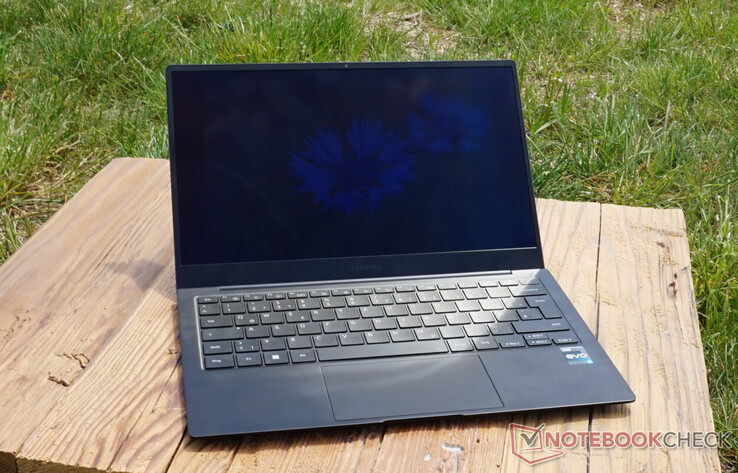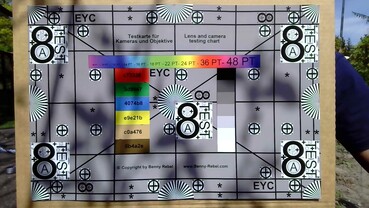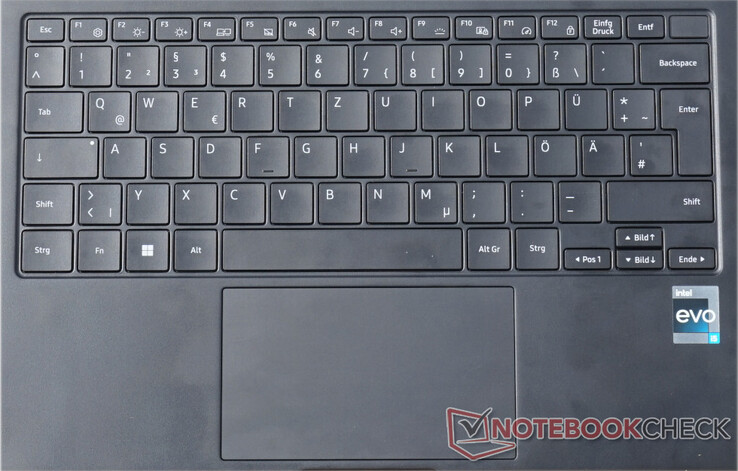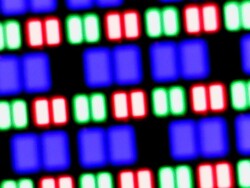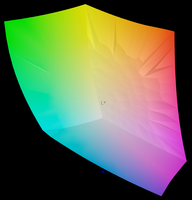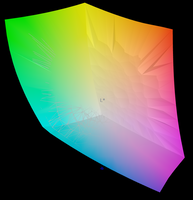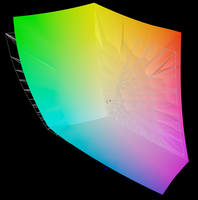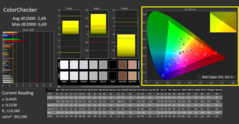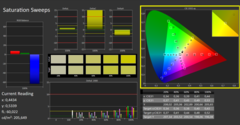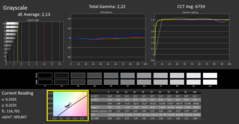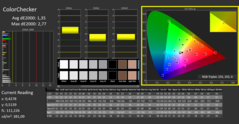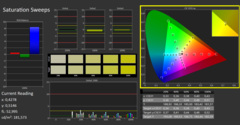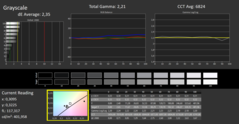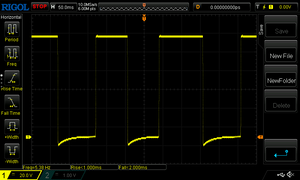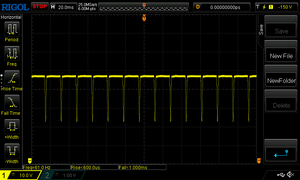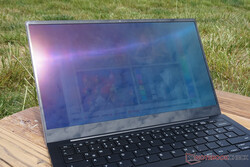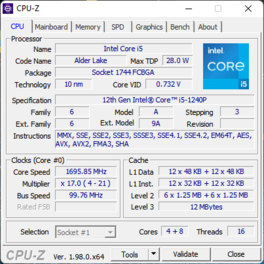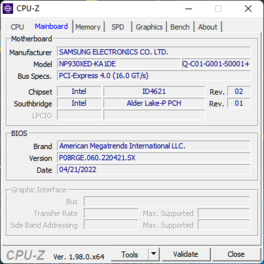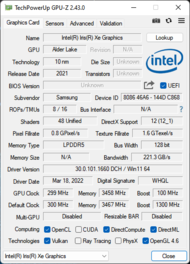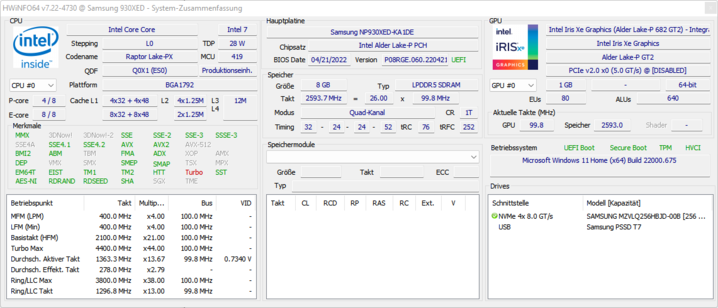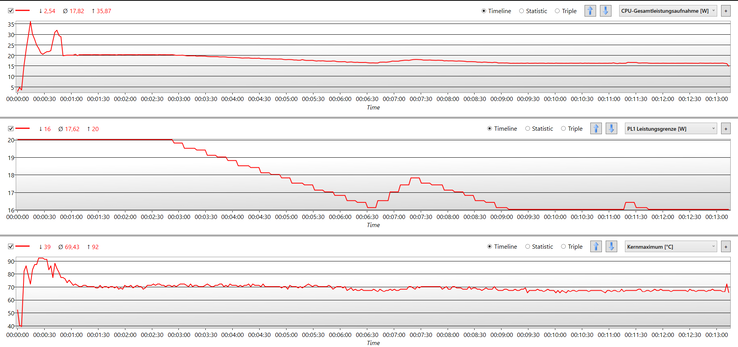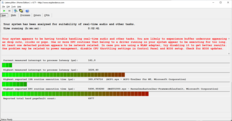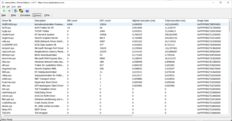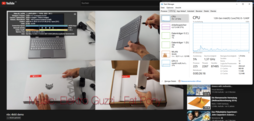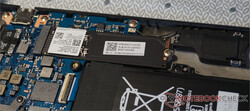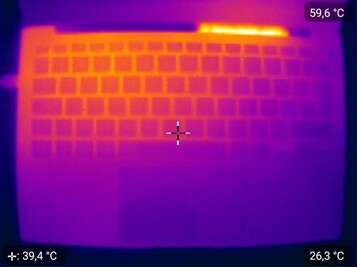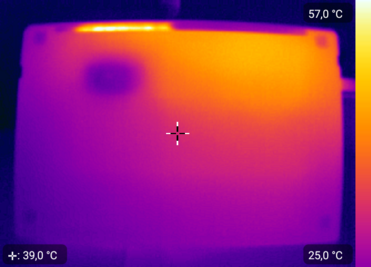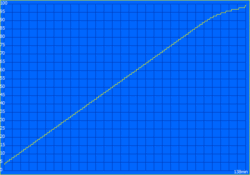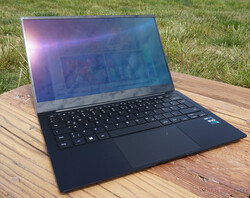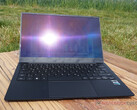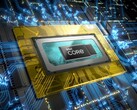Samsung Galaxy Book2 Pro 13 review: Subnotebook with efficient Alder Lake i5
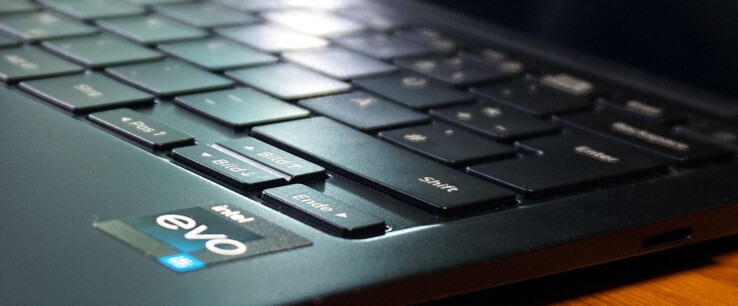
If you require a laptop that is extremely portable and always ready to go, the Samsung Galaxy Book2 Pro should at least be on your shortlist. At 13.3 inches, it offers a sufficiently large work surface while remaining lighter and smaller than most competitors. With a 12th generation i5 CPU, 8 GB of RAM and a 256 GB SSD, it is not necessarily aimed at a performance-oriented clientele, but it possesses enough power to handle almost all tasks adequately. Then there is the OLED display, which displays virtually all content a little more vividly than on a IPS, and which delivers a perfect black.
If you want to upgrade at any point, you can only (currently) choose the larger Galaxy Book, which we have already reviewed in the earlier version with an Intel Tiger Lake processor. A decision in favor of the Galaxy Book2 is therefore primarily based on size and battery life, which puts it in direct competition with an LG gram 14 that also promises maximum mobility. The somewhat dubious stability of both notebooks is thus something that we simply have to accept for now.
Possible Competitors in Comparison
Rating | Date | Model | Weight | Height | Size | Resolution | Best Price |
|---|---|---|---|---|---|---|---|
| 86.7 % | 05/2022 | Samsung Galaxy Book2 Pro 13 NP930XED-KA1DE i5-1240P, Iris Xe G7 80EUs | 885 g | 11 mm | 13.30" | 1920x1080 | |
| 87.6 % | 06/2022 | Lenovo Yoga Slim 7i Pro 14IAP G7 i5-1240P, Iris Xe G7 80EUs | 1.3 kg | 14.6 mm | 14.00" | 2880x1800 | |
| 87.8 % | 01/2022 | Lenovo ThinkBook 13s G3 20YA0005GE R7 5800U, Vega 8 | 1.3 kg | 14.9 mm | 13.30" | 1920x1200 | |
| 88.3 % | 05/2021 | LG Gram 14Z90P-G.AA79G i7-1165G7, Iris Xe G7 96EUs | 967 g | 16.8 mm | 14.00" | 1920x1200 | |
| 86.3 % | 04/2022 | VAIO SX12 VJS124X1011P i5-1155G7, Iris Xe G7 80EUs | 892 g | 17.8 mm | 12.50" | 1920x1080 | |
| 84.1 % | 03/2022 | Dell Latitude 5320-TM4V2 i5-1135G7, Iris Xe G7 80EUs | 1.3 kg | 17 mm | 13.30" | 1920x1080 |
Case: Galaxy Book in a compact chassis
The very flat, somewhat inconspicuous but nevertheless sleek case has a slightly color-contrasting screen lid out of aluminum. Otherwise, plastic dominates. The extremely low weight of under 900 g would hardly be possible otherwise.
All parts appear to fit together very precisely. Nowhere are the edges wider than absolutely necessary. In this way, Samsung ensures that the OLED display alone is the centerpiece and the notebook remains enormously compact for its screen size.
At the same time, there is no question of torsional rigidity: both the display and the base bend if they are only held at one corner.
Samsung has devised a trick to prevent users from handling the screen too roughly: A concave in the bottom part allows the screen to be opened only in the center. The very well positioned screen cannot be grasped at the corners.
We found the strong sensitivity of the entire case to fingerprints annoying and these can only be removed with effort.
The merits of the not-so-stable case are clear: With dimensions in the A4 range and a thickness of 11mm, the Galaxy Book2 Pro takes up no more space than a stack of paper. At a weight of 885g, not including the inconspicuous power supply adapter, it is one of the smallest subnotebooks - mind you, with a normal size keyboard and pleasant display dimensions. Even a small backpack or an already well-packed bag will still be able to accommodate the Galaxy Book.
Connectivity: A Samsung subnotebook with all the essentials
In keeping with the extremely compact casing, there is only a small selection of ports, which commendably include HDMI and a card slot for microSD.
USB-C and Thunderbolt 4 are also installed on the left. Unfortunately, charging is not possible from both sides. Nevertheless, the positioning makes sense. The USB-C port, which only achieves the data rate of USB 3.0, can be used for charging, while Thunderbolt remains free for everything else.
The USB-A port on the right side is unconvincing in terms of transfer speed. USB 3.0 is not exceeded here either. But this is still sufficient for simple USB sticks, external HDDs or the mouse. Nevertheless, 10 Gbit/s would have been desirable and up-to-date for both USB-A and USB-C.
SD Card Reader
Our measurement with the AV PRO microSD 128 GB V60 reference card did not reveal any abnormalities. The card slot of the Samsung Galaxy Book falls quite unerringly in the range of the average value for subnotebooks. This level of performance is sufficient for transferring 32GB in less than 10 minutes.
| SD Card Reader | |
| average JPG Copy Test (av. of 3 runs) | |
| Dell Latitude 5320-TM4V2 (AV Pro SD microSD 128 GB V60) | |
| LG Gram 14Z90P-G.AA79G (Toshiba Exceria Pro M501 microSDXC 64GB) | |
| Samsung Galaxy Book2 Pro 13 NP930XED-KA1DE (AV Pro SD microSD 128 GB V60) | |
| Average of class Subnotebook (18.9 - 193.9, n=17, last 2 years) | |
| Lenovo ThinkBook 15p G2 ITH 21B1000YGE (AV Pro V60) | |
| maximum AS SSD Seq Read Test (1GB) | |
| Dell Latitude 5320-TM4V2 (AV Pro SD microSD 128 GB V60) | |
| LG Gram 14Z90P-G.AA79G (Toshiba Exceria Pro M501 microSDXC 64GB) | |
| Samsung Galaxy Book2 Pro 13 NP930XED-KA1DE (AV Pro SD microSD 128 GB V60) | |
| Average of class Subnotebook (23.6 - 239, n=17, last 2 years) | |
| Lenovo ThinkBook 15p G2 ITH 21B1000YGE (AV Pro V60) | |
Communication
Wi-Fi 6E is fast on the Samsung Galaxy Book2 Pro 13. The transmission rate of over 1.5 GBit/s for sending and receiving is very solid and allows for the rapid transfer of large chunks of data.
Webcam
Samsung has been able to install a Full HD camera in a 3mm thick display frame. Full HD corresponds to twice the number of pixels offered by most competitors.
Unfortunately, the resulting image quality looks unusually grainy and has problems with changing light conditions. The adjustment to a darkening background in particular takes a lot of time. The color fidelity is also limited. Nevertheless, Full HD alone ensures that the Galaxy Book2 provides decent image quality during private video calls.
A good microphone also contributes to this. The dual-array design always picks up the voice at a similar volume from different spatial directions. Even from a distance of 2m and with intrusive background noise, this works convincingly.
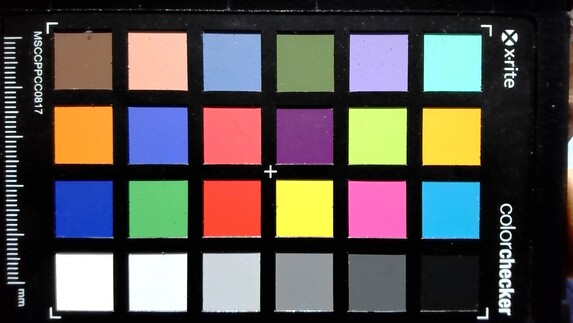
Maintenance
Opening the baseplate is surprisingly uncomplicated. The four rubber feet are not glued, but merely clamped. They can thus be levered out without damage and each have a screw underneath.
No tools are needed to detach the baseplate. Although Samsung uses the typical plastic clasps for the Galaxy Book2, they can be unfastened with little effort.
The battery and SSD are then freely accessible for replacement. Even the standalone fan can be cleaned easily. The other components, especially the Wi-Fi module and RAM, are firmly soldered.
Input Devices: The Galaxy Book offers decent quality
Samsung has installed a standard-size keyboard into the case, which is only 30cm wide. This is immediately noticeable when typing because it works flawlessly. Even the slight yielding of the keyboard frame is less annoying than would be expected from such a slim subnotebook.
The key travel amounts to just under one millimeter. More is simply not possible due to the Galaxy Book's overall thickness of 11mm. As the keystroke is firm and minimally audible, it is generally pleasant to use.
Moreover, the keyboard backlighting improves visibility in dark environments. The availability of three brightness levels to choose from means that there should be a suitable setting for every environment. However, there are no special features such as a proximity sensor to activate the backlight
The key pressure of the touchpad is also minimal. This is by no means optimal, but it is perfectly adequate. Thanks to its large size and high sensitivity, all forms of input succeed as desired. In terms of design, it is understandable that physical buttons have been omitted, but it would have certainly increased usability.
Display: OLED makes the difference in the Galaxy Book2
A dark film scene shows quite impressively what the OLED display is capable of. Because the self-illuminating pixels simply remain switched off when black areas are displayed, a deep, dark black is actually shown.
This naturally has an effect on the contrast, giving the colors a completely different vibrancy than on an IPS or TN panel with a backlight. Added to this is the slightly above-average peak brightness of 403 cd/m², near-complete coverage of the DCI-P3 color space and an outstanding response time of 4ms.
All in all, this is perfect for streaming suitably high-quality content - aside from the small screen size.
Thanks to OLED technology, screen bleeding cannot occur. However, typical for OLED displays (Samsung calls it AMOLED in the case of an active matrix OLED) is the darkening of individual stripes in the image, especially at lower brightness levels. This results in a phenomenon that is somewhat comparable to the flickering caused by pulse width modulation.
Our measurements showed a refresh rate of 61 Hz at less than 90% screen brightness, which is perceptible, but the effect should not be confused with flickering: it is more like a smooth image gradient. So those who are sensitive to PWM flickering should not be bothered by this particular dynamic of OLEDs.
The bottom example photo shows an exposure time of 1/160 s or 6ms. Here, the aforementioned distortion (black bars) is no longer perceptible. At only 1 ms, on the other hand, far below human perception, the black bars are unambiguous. Even at maximum brightness, one such bar is present, but only visible at an exposure time of 1/4000 s.
| |||||||||||||||||||||||||
Brightness Distribution: 98 %
Center on Battery: 334 cd/m²
Contrast: 5700:1 (Black: 0.07 cd/m²)
ΔE Color 1.35 | 0.5-29.43 Ø5, calibrated: 1.35
ΔE Greyscale 2.35 | 0.57-98 Ø5.3
95.55% AdobeRGB 1998 (Argyll 2.2.0 3D)
100% sRGB (Argyll 2.2.0 3D)
99.81% Display P3 (Argyll 2.2.0 3D)
Gamma: 2.21
| Samsung Galaxy Book2 Pro 13 NP930XED-KA1DE ATNA33XC10-0, OLED, 1920x1080, 13.30 | Lenovo Yoga Slim 7i Pro 14IAP G7 LEN140WQ+, IPS, 2880x1800, 14.00 | LG Gram 14Z90P-G.AA79G LG Display LP140WU1-SPA1, IPS, 1920x1200, 14.00 | VAIO SX12 VJS124X1011P Chi Mei N125HCG-GQ1, IPS, 1920x1080, 12.50 | Samsung Galaxy Book Pro 360 15 NP950QDB-KC3DE SDC4159, OLED, 1920x1080, 15.60 | Asus Zenbook Pro 15 OLED UM535Q Samsung ATNA56YX03-0, OLED, 1920x1080, 15.60 | |
|---|---|---|---|---|---|---|
| Display | -13% | -4% | -20% | 1% | -11% | |
| Display P3 Coverage | 99.81 | 77.7 -22% | 97.6 -2% | 67.6 -32% | 99.9 0% | 79.3 -21% |
| sRGB Coverage | 100 | 100 0% | 99.9 0% | 99.2 -1% | 100 0% | 95.6 -4% |
| AdobeRGB 1998 Coverage | 95.55 | 78.4 -18% | 85.3 -11% | 69.4 -27% | 97.6 2% | 87.3 -9% |
| Response Times | -780% | -1038% | -1690% | 16% | 10% | |
| Response Time Grey 50% / Grey 80% * | 4 ? | 35.2 ? -780% | 45 ? -1025% | 60 ? -1400% | 2 ? 50% | 2.1 ? 47% |
| Response Time Black / White * | 2 ? | 17.6 ? -780% | 23 ? -1050% | 41.6 ? -1980% | 2 ? -0% | 2.3 ? -15% |
| PWM Frequency | 61 ? | 60 -2% | 60.2 -1% | |||
| Screen | -42% | -89% | -20% | -17% | -24% | |
| Brightness middle | 399 | 469 18% | 352 -12% | 384.8 -4% | 290 -27% | 342.9 -14% |
| Brightness | 403 | 445 10% | 332 -18% | 361 -10% | 290 -28% | 346 -14% |
| Brightness Distribution | 98 | 90 -8% | 91 -7% | 90 -8% | 99 1% | 98 0% |
| Black Level * | 0.07 | 0.22 -214% | 0.18 -157% | 0.05 29% | ||
| Contrast | 5700 | 1600 -72% | 2138 -62% | 5800 2% | ||
| Colorchecker dE 2000 * | 1.35 | 3.5 -159% | 2.89 -114% | 1.54 -14% | 1.84 -36% | 2.42 -79% |
| Colorchecker dE 2000 max. * | 2.77 | 5.3 -91% | 4.66 -68% | 2.95 -6% | 3.83 -38% | 4.05 -46% |
| Colorchecker dE 2000 calibrated * | 1.35 | 1.7 -26% | 2.7 -100% | 0.96 29% | 2.69 -99% | |
| Greyscale dE 2000 * | 2.35 | 3.3 -40% | 6.9 -194% | 1.2 49% | 1.24 47% | 2.1 11% |
| Gamma | 2.21 100% | 1.97 112% | 2.34 94% | 2.1 105% | 2.2 100% | 2.21 100% |
| CCT | 6824 95% | 6512 100% | 7904 82% | 6419 101% | 6686 97% | 6364 102% |
| Color Space (Percent of AdobeRGB 1998) | 76 | |||||
| Color Space (Percent of sRGB) | 100 | |||||
| Total Average (Program / Settings) | -278% /
-158% | -377% /
-206% | -577% /
-259% | 0% /
-7% | -8% /
-12% |
* ... smaller is better
No wishes remain unfulfilled in the representation of colors. The particularly extensive DCI-P3 color space is virtually completely covered. Only the color space AdobeRGB 1998, which extends far into the green, cannot be completely covered by the OLED display.
This is sufficient even for professional requirements, especially considering that, after calibration, even the largest deviation from the actual color is still below the usual threshold for human perception. Uncalibrated, on the other hand, a trained eye may still notice one or two color distortions.
The ICC profile we created for this can be downloaded in the box with the panel data.
Display Response Times
| ↔ Response Time Black to White | ||
|---|---|---|
| 2 ms ... rise ↗ and fall ↘ combined | ↗ 1 ms rise | |
| ↘ 1 ms fall | ||
| The screen shows very fast response rates in our tests and should be very well suited for fast-paced gaming. In comparison, all tested devices range from 0.1 (minimum) to 240 (maximum) ms. » 6 % of all devices are better. This means that the measured response time is better than the average of all tested devices (21.5 ms). | ||
| ↔ Response Time 50% Grey to 80% Grey | ||
| 4 ms ... rise ↗ and fall ↘ combined | ↗ 2 ms rise | |
| ↘ 2 ms fall | ||
| The screen shows very fast response rates in our tests and should be very well suited for fast-paced gaming. In comparison, all tested devices range from 0.2 (minimum) to 636 (maximum) ms. » 10 % of all devices are better. This means that the measured response time is better than the average of all tested devices (33.7 ms). | ||
Screen Flickering / PWM (Pulse-Width Modulation)
| Screen flickering / PWM detected | 61 Hz | ≤ 90 % brightness setting | |
The display backlight flickers at 61 Hz (worst case, e.g., utilizing PWM) Flickering detected at a brightness setting of 90 % and below. There should be no flickering or PWM above this brightness setting. The frequency of 61 Hz is very low, so the flickering may cause eyestrain and headaches after extended use. In comparison: 53 % of all tested devices do not use PWM to dim the display. If PWM was detected, an average of 17924 (minimum: 5 - maximum: 3846000) Hz was measured. | |||
Thanks to its peak brightness of up to 400 cd/m², working outdoors seems possible, at least in theory. However, this value drops to 330 cd/m² in battery mode. Furthermore, the advantage of the low black level cannot be fully exploited in bright environments.
In combination with a reflective display, not much can be seen, at least in sunlight. Away from the light and in the shade, on the other hand, display content can be read relatively normally as long as there are no reflections from bright surfaces in the background. Overall, the strengths of the Galaxy Book's display come to the fore indoors.
Performance: Samsung's laptop has little room to unfold
The Intel Alder Lake i5-1240P processor used in the Galaxy Book2 Pro does not have to hide in terms of computing power, even if it cannot fully utilize its potential here due to restrictions of space and the focus on a long battery life.
Only 8GB of RAM, on the other hand, is a point of criticism, even if it should suffice for most tasks. Either way, the notebook may resent the spontaneous opening of thirty browser tabs and respond with a somewhat longer loading time.
All in all, the subnotebook - as is typical for its class - is designed for quiet and long lasting operation. If you want top performance, however, you would need a much larger, heavier and more expensive laptop.
Test Conditions
Samsung has installed a separate function key for performance profiles. The secondary function of F11 allows the selection of High Performance, Optimized, Quiet and Silent. All performance tests were carried out at High Performance. Here, the processor consumes 40 W for fractions of a second, gradually dropping to 20 W over a period of 28s before falling even further.
The other performance modes are mainly for fan control. At the lowest level, the CPU's power supply is reduced to 9 W so that the fan remains silent. Here, the setting has no effect on battery life, as the processor remains well below this level of power consumption for simple surfing or video streaming.
Processor
The Intel Core i5-1240P provides impressive fundamentals, namely four powerful cores as well as eight additional processors geared towards efficiency. Because the so-called performance cores are also capable of hyperthreading, up to 16 computing tasks can run in parallel.
However, Samsung had to limit the performance significantly. Instead of the usual 28 W of power supply, the CPU is only allowed to treat itself to 20 W. The standalone fan, which hardly gets enough airflow in the slim case, can only dissipate the heat to a limited extent. Over longer periods, computing power cannot be maintained and the power supply is further limited.
This should never be a problem. A few seconds of maximum performance are sufficient for tasks that have to be carried out when surfing, streaming, editing documents or graphics. Afterwards, the processor has enough time to cool down again.
The trimmed performance (at least in the Cinebench 15 loop) is nonetheless still on par with an i7-1165G7, which is used in strong business notebooks. However, the gap to a better-cooled i5-1240P remains more than considerable. Further processor benchmarks can be found in our database.
Cinebench R15 Multi Sustained Load
If constantly high performance is needed over longer periods of time, the system gradually adjusts the current consumption allowed. In the example shown here, this remains at 16 W after nine minutes. In this way, the core temperature can also be kept at 70 °C. Higher temperatures would make the case uncomfortably hot.
Because the throttling starts after a few moments, the measured performance remains constant, for example, when Cinebench is run repeatedly.
Cinebench R23: Multi Core | Single Core
Cinebench R20: CPU (Multi Core) | CPU (Single Core)
Cinebench R15: CPU Multi 64Bit | CPU Single 64Bit
Blender: v2.79 BMW27 CPU
7-Zip 18.03: 7z b 4 | 7z b 4 -mmt1
Geekbench 5.5: Multi-Core | Single-Core
HWBOT x265 Benchmark v2.2: 4k Preset
LibreOffice : 20 Documents To PDF
R Benchmark 2.5: Overall mean
| CPU Performance Rating | |
| Lenovo Yoga Slim 7i Pro 14IAP G7 | |
| Average of class Subnotebook | |
| Lenovo ThinkBook 13s G3 20YA0005GE | |
| Average Intel Core i5-1240P | |
| VAIO SX12 VJS124X1011P | |
| LG Gram 14Z90P-G.AA79G | |
| Dell Latitude 5320-TM4V2 -1! | |
| Samsung Galaxy Book2 Pro 13 NP930XED-KA1DE | |
| Cinebench R23 / Multi Core | |
| Lenovo Yoga Slim 7i Pro 14IAP G7 | |
| Average of class Subnotebook (2485 - 16201, n=68, last 2 years) | |
| Lenovo ThinkBook 13s G3 20YA0005GE | |
| Average Intel Core i5-1240P (277 - 11556, n=20) | |
| Samsung Galaxy Book2 Pro 13 NP930XED-KA1DE | |
| VAIO SX12 VJS124X1011P | |
| Dell Latitude 5320-TM4V2 | |
| LG Gram 14Z90P-G.AA79G | |
| Cinebench R23 / Single Core | |
| Lenovo Yoga Slim 7i Pro 14IAP G7 | |
| Average of class Subnotebook (598 - 1934, n=68, last 2 years) | |
| Average Intel Core i5-1240P (640 - 1689, n=18) | |
| Lenovo ThinkBook 13s G3 20YA0005GE | |
| VAIO SX12 VJS124X1011P | |
| LG Gram 14Z90P-G.AA79G | |
| Dell Latitude 5320-TM4V2 | |
| Samsung Galaxy Book2 Pro 13 NP930XED-KA1DE | |
| Cinebench R20 / CPU (Multi Core) | |
| Lenovo Yoga Slim 7i Pro 14IAP G7 | |
| Average of class Subnotebook (810 - 6314, n=64, last 2 years) | |
| Average Intel Core i5-1240P (763 - 4456, n=16) | |
| Lenovo ThinkBook 13s G3 20YA0005GE | |
| Samsung Galaxy Book2 Pro 13 NP930XED-KA1DE | |
| VAIO SX12 VJS124X1011P | |
| Dell Latitude 5320-TM4V2 | |
| LG Gram 14Z90P-G.AA79G | |
| Cinebench R20 / CPU (Single Core) | |
| Lenovo Yoga Slim 7i Pro 14IAP G7 | |
| Average of class Subnotebook (216 - 738, n=64, last 2 years) | |
| Lenovo ThinkBook 13s G3 20YA0005GE | |
| VAIO SX12 VJS124X1011P | |
| Average Intel Core i5-1240P (251 - 653, n=16) | |
| LG Gram 14Z90P-G.AA79G | |
| Dell Latitude 5320-TM4V2 | |
| Samsung Galaxy Book2 Pro 13 NP930XED-KA1DE | |
| Cinebench R15 / CPU Multi 64Bit | |
| Lenovo ThinkBook 13s G3 20YA0005GE | |
| Lenovo ThinkBook 13s G3 20YA0005GE | |
| Lenovo Yoga Slim 7i Pro 14IAP G7 | |
| Average of class Subnotebook (514 - 2581, n=70, last 2 years) | |
| Average Intel Core i5-1240P (407 - 2007, n=19) | |
| Samsung Galaxy Book2 Pro 13 NP930XED-KA1DE | |
| VAIO SX12 VJS124X1011P | |
| LG Gram 14Z90P-G.AA79G | |
| Dell Latitude 5320-TM4V2 | |
| Cinebench R15 / CPU Single 64Bit | |
| Average of class Subnotebook (91.8 - 280, n=62, last 2 years) | |
| Lenovo Yoga Slim 7i Pro 14IAP G7 | |
| Lenovo ThinkBook 13s G3 20YA0005GE | |
| VAIO SX12 VJS124X1011P | |
| Average Intel Core i5-1240P (91.8 - 243, n=18) | |
| LG Gram 14Z90P-G.AA79G | |
| Dell Latitude 5320-TM4V2 | |
| Samsung Galaxy Book2 Pro 13 NP930XED-KA1DE | |
| Blender / v2.79 BMW27 CPU | |
| LG Gram 14Z90P-G.AA79G | |
| Dell Latitude 5320-TM4V2 | |
| Samsung Galaxy Book2 Pro 13 NP930XED-KA1DE | |
| VAIO SX12 VJS124X1011P | |
| Average Intel Core i5-1240P (285 - 1926, n=16) | |
| Lenovo ThinkBook 13s G3 20YA0005GE | |
| Average of class Subnotebook (201 - 1600, n=66, last 2 years) | |
| Lenovo Yoga Slim 7i Pro 14IAP G7 | |
| 7-Zip 18.03 / 7z b 4 | |
| Lenovo Yoga Slim 7i Pro 14IAP G7 | |
| Average of class Subnotebook (16223 - 67444, n=57, last 2 years) | |
| Lenovo ThinkBook 13s G3 20YA0005GE | |
| Average Intel Core i5-1240P (7254 - 47002, n=16) | |
| VAIO SX12 VJS124X1011P | |
| Samsung Galaxy Book2 Pro 13 NP930XED-KA1DE | |
| Dell Latitude 5320-TM4V2 | |
| LG Gram 14Z90P-G.AA79G | |
| 7-Zip 18.03 / 7z b 4 -mmt1 | |
| Average of class Subnotebook (2197 - 6403, n=58, last 2 years) | |
| Lenovo ThinkBook 13s G3 20YA0005GE | |
| VAIO SX12 VJS124X1011P | |
| Lenovo Yoga Slim 7i Pro 14IAP G7 | |
| LG Gram 14Z90P-G.AA79G | |
| Dell Latitude 5320-TM4V2 | |
| Average Intel Core i5-1240P (2197 - 5320, n=16) | |
| Samsung Galaxy Book2 Pro 13 NP930XED-KA1DE | |
| Geekbench 5.5 / Multi-Core | |
| Lenovo Yoga Slim 7i Pro 14IAP G7 | |
| Average of class Subnotebook (4274 - 12580, n=65, last 2 years) | |
| Average Intel Core i5-1240P (1763 - 10112, n=15) | |
| Lenovo ThinkBook 13s G3 20YA0005GE | |
| VAIO SX12 VJS124X1011P | |
| LG Gram 14Z90P-G.AA79G | |
| Samsung Galaxy Book2 Pro 13 NP930XED-KA1DE | |
| Dell Latitude 5320-TM4V2 | |
| Geekbench 5.5 / Single-Core | |
| Average of class Subnotebook (672 - 2350, n=65, last 2 years) | |
| Lenovo Yoga Slim 7i Pro 14IAP G7 | |
| Average Intel Core i5-1240P (672 - 1658, n=15) | |
| LG Gram 14Z90P-G.AA79G | |
| VAIO SX12 VJS124X1011P | |
| Lenovo ThinkBook 13s G3 20YA0005GE | |
| Dell Latitude 5320-TM4V2 | |
| Samsung Galaxy Book2 Pro 13 NP930XED-KA1DE | |
| HWBOT x265 Benchmark v2.2 / 4k Preset | |
| Lenovo Yoga Slim 7i Pro 14IAP G7 | |
| Average of class Subnotebook (1.5 - 19.4, n=56, last 2 years) | |
| Lenovo ThinkBook 13s G3 20YA0005GE | |
| Average Intel Core i5-1240P (1.99 - 12.9, n=16) | |
| VAIO SX12 VJS124X1011P | |
| Samsung Galaxy Book2 Pro 13 NP930XED-KA1DE | |
| LG Gram 14Z90P-G.AA79G | |
| LibreOffice / 20 Documents To PDF | |
| Samsung Galaxy Book2 Pro 13 NP930XED-KA1DE | |
| Average Intel Core i5-1240P (46.4 - 120.5, n=16) | |
| Dell Latitude 5320-TM4V2 | |
| VAIO SX12 VJS124X1011P | |
| Average of class Subnotebook (40.1 - 120.5, n=57, last 2 years) | |
| Lenovo Yoga Slim 7i Pro 14IAP G7 | |
| Lenovo ThinkBook 13s G3 20YA0005GE | |
| LG Gram 14Z90P-G.AA79G | |
| R Benchmark 2.5 / Overall mean | |
| Samsung Galaxy Book2 Pro 13 NP930XED-KA1DE | |
| Dell Latitude 5320-TM4V2 | |
| LG Gram 14Z90P-G.AA79G | |
| VAIO SX12 VJS124X1011P | |
| Average Intel Core i5-1240P (0.4987 - 1.236, n=16) | |
| Lenovo ThinkBook 13s G3 20YA0005GE | |
| Average of class Subnotebook (0.4397 - 1.236, n=57, last 2 years) | |
| Lenovo Yoga Slim 7i Pro 14IAP G7 | |
* ... smaller is better
AIDA64: FP32 Ray-Trace | FPU Julia | CPU SHA3 | CPU Queen | FPU SinJulia | FPU Mandel | CPU AES | CPU ZLib | FP64 Ray-Trace | CPU PhotoWorxx
| Performance Rating | |
| Lenovo ThinkBook 13s G3 20YA0005GE | |
| Average of class Subnotebook | |
| Lenovo Yoga Slim 7i Pro 14IAP G7 | |
| VAIO SX12 VJS124X1011P | |
| Average Intel Core i5-1240P | |
| LG Gram 14Z90P-G.AA79G | |
| Dell Latitude 5320-TM4V2 | |
| Samsung Galaxy Book2 Pro 13 NP930XED-KA1DE | |
| AIDA64 / FP32 Ray-Trace | |
| Lenovo ThinkBook 13s G3 20YA0005GE | |
| Average of class Subnotebook (343 - 25961, n=57, last 2 years) | |
| VAIO SX12 VJS124X1011P | |
| Average Intel Core i5-1240P (2405 - 9694, n=16) | |
| Lenovo Yoga Slim 7i Pro 14IAP G7 | |
| Dell Latitude 5320-TM4V2 | |
| LG Gram 14Z90P-G.AA79G | |
| Samsung Galaxy Book2 Pro 13 NP930XED-KA1DE | |
| AIDA64 / FPU Julia | |
| Lenovo ThinkBook 13s G3 20YA0005GE | |
| Average of class Subnotebook (11867 - 111109, n=57, last 2 years) | |
| VAIO SX12 VJS124X1011P | |
| Average Intel Core i5-1240P (7407 - 49934, n=16) | |
| Lenovo Yoga Slim 7i Pro 14IAP G7 | |
| Dell Latitude 5320-TM4V2 | |
| LG Gram 14Z90P-G.AA79G | |
| Samsung Galaxy Book2 Pro 13 NP930XED-KA1DE | |
| AIDA64 / CPU SHA3 | |
| Lenovo ThinkBook 13s G3 20YA0005GE | |
| Average of class Subnotebook (453 - 4646, n=57, last 2 years) | |
| VAIO SX12 VJS124X1011P | |
| Lenovo Yoga Slim 7i Pro 14IAP G7 | |
| Average Intel Core i5-1240P (415 - 2462, n=16) | |
| Dell Latitude 5320-TM4V2 | |
| LG Gram 14Z90P-G.AA79G | |
| Samsung Galaxy Book2 Pro 13 NP930XED-KA1DE | |
| AIDA64 / CPU Queen | |
| Lenovo ThinkBook 13s G3 20YA0005GE | |
| Average of class Subnotebook (15447 - 115300, n=57, last 2 years) | |
| Lenovo Yoga Slim 7i Pro 14IAP G7 | |
| Average Intel Core i5-1240P (29405 - 76736, n=16) | |
| VAIO SX12 VJS124X1011P | |
| LG Gram 14Z90P-G.AA79G | |
| Dell Latitude 5320-TM4V2 | |
| Samsung Galaxy Book2 Pro 13 NP930XED-KA1DE | |
| AIDA64 / FPU SinJulia | |
| Lenovo ThinkBook 13s G3 20YA0005GE | |
| Average of class Subnotebook (1223 - 14944, n=57, last 2 years) | |
| Lenovo Yoga Slim 7i Pro 14IAP G7 | |
| Average Intel Core i5-1240P (2135 - 6540, n=16) | |
| VAIO SX12 VJS124X1011P | |
| LG Gram 14Z90P-G.AA79G | |
| Dell Latitude 5320-TM4V2 | |
| Samsung Galaxy Book2 Pro 13 NP930XED-KA1DE | |
| AIDA64 / FPU Mandel | |
| Lenovo ThinkBook 13s G3 20YA0005GE | |
| Average of class Subnotebook (6379 - 59053, n=57, last 2 years) | |
| VAIO SX12 VJS124X1011P | |
| Lenovo Yoga Slim 7i Pro 14IAP G7 | |
| Average Intel Core i5-1240P (5113 - 23992, n=16) | |
| Dell Latitude 5320-TM4V2 | |
| LG Gram 14Z90P-G.AA79G | |
| Samsung Galaxy Book2 Pro 13 NP930XED-KA1DE | |
| AIDA64 / CPU AES | |
| Lenovo ThinkBook 13s G3 20YA0005GE | |
| VAIO SX12 VJS124X1011P | |
| LG Gram 14Z90P-G.AA79G | |
| Average of class Subnotebook (638 - 161430, n=57, last 2 years) | |
| Lenovo Yoga Slim 7i Pro 14IAP G7 | |
| Average Intel Core i5-1240P (8849 - 90370, n=16) | |
| Dell Latitude 5320-TM4V2 | |
| Samsung Galaxy Book2 Pro 13 NP930XED-KA1DE | |
| AIDA64 / CPU ZLib | |
| Lenovo Yoga Slim 7i Pro 14IAP G7 | |
| Average of class Subnotebook (270 - 1123, n=57, last 2 years) | |
| Lenovo ThinkBook 13s G3 20YA0005GE | |
| Average Intel Core i5-1240P (101.6 - 812, n=16) | |
| VAIO SX12 VJS124X1011P | |
| Samsung Galaxy Book2 Pro 13 NP930XED-KA1DE | |
| Dell Latitude 5320-TM4V2 | |
| LG Gram 14Z90P-G.AA79G | |
| AIDA64 / FP64 Ray-Trace | |
| Lenovo ThinkBook 13s G3 20YA0005GE | |
| Average of class Subnotebook (204 - 14018, n=57, last 2 years) | |
| VAIO SX12 VJS124X1011P | |
| Lenovo Yoga Slim 7i Pro 14IAP G7 | |
| Average Intel Core i5-1240P (1154 - 5258, n=16) | |
| Dell Latitude 5320-TM4V2 | |
| LG Gram 14Z90P-G.AA79G | |
| Samsung Galaxy Book2 Pro 13 NP930XED-KA1DE | |
| AIDA64 / CPU PhotoWorxx | |
| LG Gram 14Z90P-G.AA79G | |
| VAIO SX12 VJS124X1011P | |
| Lenovo Yoga Slim 7i Pro 14IAP G7 | |
| Average of class Subnotebook (7622 - 53954, n=57, last 2 years) | |
| Average Intel Core i5-1240P (11873 - 43661, n=16) | |
| Samsung Galaxy Book2 Pro 13 NP930XED-KA1DE | |
| Dell Latitude 5320-TM4V2 | |
| Lenovo ThinkBook 13s G3 20YA0005GE | |
System Performance
Aside from the continuous performance of the CPU, the Samsung Galaxy Book2 Pro is on par with its competitors. Despite its limited cooling capabilities, the current processor architecture can keep up with the previous generation - in much smaller and lighter housing.
This is exactly the impression one has when using the subnotebook. Processes start immediately and are completed quickly. At no time does anything stutter: this also applies to the additional power-reduced modes and battery mode. Only multitasking proves to be somewhat of a challenge.
CrossMark: Overall | Productivity | Creativity | Responsiveness
| PCMark 10 / Score | |
| Lenovo ThinkBook 13s G3 20YA0005GE | |
| Average of class Subnotebook (4384 - 7428, n=55, last 2 years) | |
| Lenovo Yoga Slim 7i Pro 14IAP G7 | |
| VAIO SX12 VJS124X1011P | |
| Average Intel Core i5-1240P, Intel Iris Xe Graphics G7 80EUs (4881 - 5345, n=11) | |
| Samsung Galaxy Book2 Pro 13 NP930XED-KA1DE | |
| LG Gram 14Z90P-G.AA79G | |
| Dell Latitude 5320-TM4V2 | |
| PCMark 10 / Essentials | |
| VAIO SX12 VJS124X1011P | |
| Average of class Subnotebook (8890 - 11168, n=55, last 2 years) | |
| Lenovo ThinkBook 13s G3 20YA0005GE | |
| LG Gram 14Z90P-G.AA79G | |
| Lenovo Yoga Slim 7i Pro 14IAP G7 | |
| Average Intel Core i5-1240P, Intel Iris Xe Graphics G7 80EUs (8890 - 10652, n=11) | |
| Samsung Galaxy Book2 Pro 13 NP930XED-KA1DE | |
| Dell Latitude 5320-TM4V2 | |
| PCMark 10 / Productivity | |
| Lenovo ThinkBook 13s G3 20YA0005GE | |
| Average of class Subnotebook (6213 - 10279, n=55, last 2 years) | |
| LG Gram 14Z90P-G.AA79G | |
| VAIO SX12 VJS124X1011P | |
| Average Intel Core i5-1240P, Intel Iris Xe Graphics G7 80EUs (6118 - 7058, n=11) | |
| Samsung Galaxy Book2 Pro 13 NP930XED-KA1DE | |
| Lenovo Yoga Slim 7i Pro 14IAP G7 | |
| Dell Latitude 5320-TM4V2 | |
| PCMark 10 / Digital Content Creation | |
| Average of class Subnotebook (4093 - 9749, n=55, last 2 years) | |
| Lenovo ThinkBook 13s G3 20YA0005GE | |
| Lenovo Yoga Slim 7i Pro 14IAP G7 | |
| Average Intel Core i5-1240P, Intel Iris Xe Graphics G7 80EUs (5169 - 6213, n=11) | |
| VAIO SX12 VJS124X1011P | |
| Samsung Galaxy Book2 Pro 13 NP930XED-KA1DE | |
| Dell Latitude 5320-TM4V2 | |
| LG Gram 14Z90P-G.AA79G | |
| CrossMark / Overall | |
| Average of class Subnotebook (718 - 1876, n=61, last 2 years) | |
| Lenovo Yoga Slim 7i Pro 14IAP G7 | |
| Average Intel Core i5-1240P, Intel Iris Xe Graphics G7 80EUs (1392 - 1553, n=7) | |
| Lenovo ThinkBook 13s G3 20YA0005GE | |
| Dell Latitude 5320-TM4V2 | |
| CrossMark / Productivity | |
| Average of class Subnotebook (685 - 1829, n=61, last 2 years) | |
| Average Intel Core i5-1240P, Intel Iris Xe Graphics G7 80EUs (1393 - 1524, n=7) | |
| Lenovo Yoga Slim 7i Pro 14IAP G7 | |
| Lenovo ThinkBook 13s G3 20YA0005GE | |
| Dell Latitude 5320-TM4V2 | |
| CrossMark / Creativity | |
| Average of class Subnotebook (776 - 2210, n=61, last 2 years) | |
| Lenovo Yoga Slim 7i Pro 14IAP G7 | |
| Average Intel Core i5-1240P, Intel Iris Xe Graphics G7 80EUs (1426 - 1647, n=7) | |
| Lenovo ThinkBook 13s G3 20YA0005GE | |
| Dell Latitude 5320-TM4V2 | |
| CrossMark / Responsiveness | |
| Average Intel Core i5-1240P, Intel Iris Xe Graphics G7 80EUs (1267 - 1545, n=7) | |
| Average of class Subnotebook (652 - 1899, n=61, last 2 years) | |
| Lenovo Yoga Slim 7i Pro 14IAP G7 | |
| Lenovo ThinkBook 13s G3 20YA0005GE | |
| Dell Latitude 5320-TM4V2 | |
| PCMark 10 Score | 4881 points | |
Help | ||
| AIDA64 / Memory Copy | |
| LG Gram 14Z90P-G.AA79G | |
| VAIO SX12 VJS124X1011P | |
| Average of class Subnotebook (22781 - 95353, n=57, last 2 years) | |
| Lenovo Yoga Slim 7i Pro 14IAP G7 | |
| Samsung Galaxy Book2 Pro 13 NP930XED-KA1DE | |
| Average Intel Core i5-1240P (23312 - 70537, n=16) | |
| Lenovo ThinkBook 13s G3 20YA0005GE | |
| Dell Latitude 5320-TM4V2 | |
| AIDA64 / Memory Read | |
| Lenovo Yoga Slim 7i Pro 14IAP G7 | |
| LG Gram 14Z90P-G.AA79G | |
| VAIO SX12 VJS124X1011P | |
| Average of class Subnotebook (23831 - 86433, n=57, last 2 years) | |
| Average Intel Core i5-1240P (18989 - 70553, n=16) | |
| Samsung Galaxy Book2 Pro 13 NP930XED-KA1DE | |
| Dell Latitude 5320-TM4V2 | |
| Lenovo ThinkBook 13s G3 20YA0005GE | |
| AIDA64 / Memory Write | |
| VAIO SX12 VJS124X1011P | |
| LG Gram 14Z90P-G.AA79G | |
| Average of class Subnotebook (23474 - 93382, n=57, last 2 years) | |
| Lenovo Yoga Slim 7i Pro 14IAP G7 | |
| Samsung Galaxy Book2 Pro 13 NP930XED-KA1DE | |
| Average Intel Core i5-1240P (23454 - 62496, n=16) | |
| Dell Latitude 5320-TM4V2 | |
| Lenovo ThinkBook 13s G3 20YA0005GE | |
| AIDA64 / Memory Latency | |
| Average Intel Core i5-1240P (85.1 - 188.3, n=11) | |
| Lenovo ThinkBook 13s G3 20YA0005GE | |
| Average of class Subnotebook (18.8 - 172, n=52, last 2 years) | |
| VAIO SX12 VJS124X1011P | |
| LG Gram 14Z90P-G.AA79G | |
| Dell Latitude 5320-TM4V2 | |
* ... smaller is better
DPC Latencies
The latencies in Prime95, Microsoft Edge and YouTube during 4K video playback are clearly too high. The long waiting time in the kernel mode driver framework likely indicates a conflict between some drivers.
As long as no real-time audio processing takes place, which is usually not carried out on a subnotebook, this should not play a role. On the other hand, it is remarkable that not a single frame was omitted during 4K video playback.
| DPC Latencies / LatencyMon - interrupt to process latency (max), Web, Youtube, Prime95 | |
| Samsung Galaxy Book2 Pro 13 NP930XED-KA1DE | |
| Dell Latitude 5320-TM4V2 | |
| LG Gram 14Z90P-G.AA79G | |
| Lenovo Yoga Slim 7i Pro 14IAP G7 | |
| VAIO SX12 VJS124X1011P | |
| Lenovo ThinkBook 13s G3 20YA0005GE | |
* ... smaller is better
Storage Devices
The measured values of the SSD are average. Compared to competitors with PCIe 4.0 for the connection of the SSD, the mass storage device used here appears slower.
On the other hand, the M.2 SSD achieves the typical values for the model used, and at no time should the write and read speeds have a negative impact. To the contrary: the system should never be able to fully utilize the given transfer rates.
| Samsung Galaxy Book2 Pro 13 NP930XED-KA1DE Samsung PM991a MZVLQ256HBJD | Lenovo Yoga Slim 7i Pro 14IAP G7 Samsung PM9A1 MZVL2512HCJQ | Lenovo ThinkBook 13s G3 20YA0005GE WDC PC SN530 SDBPNPZ-512G | LG Gram 14Z90P-G.AA79G SK Hynix PC601 1TB HFS001TD9TNG | VAIO SX12 VJS124X1011P Samsung PM9A1 MZVL2512HCJQ | Dell Latitude 5320-TM4V2 Toshiba KBG40ZNS256G NVMe | Average Samsung PM991a MZVLQ256HBJD | Average of class Subnotebook | |
|---|---|---|---|---|---|---|---|---|
| Drive Performance Rating | ||||||||
| Percent | 37.8 | 69.1 83% | 47.4 25% | 64.4 70% | 96.7 156% | 28.5 -25% | 40.9 8% | 66.3 75% |
| DiskSpd | 130% | 28% | 97% | 215% | 7% | 15% | 113% | |
| seq read | 1469 | 3768 157% | 1778 21% | 1750 19% | 4027 174% | 1414 -4% | 1640 ? 12% | 2872 ? 96% |
| seq write | 1129 | 2781 146% | 1774 57% | 2509 122% | 3415 202% | 1390 23% | 1182 ? 5% | 2808 ? 149% |
| seq q8 t1 read | 1584 | 6661 321% | 2488 57% | 3447 118% | 6727 325% | 2407 52% | 2411 ? 52% | 4958 ? 213% |
| seq q8 t1 write | 1014 | 4864 380% | 1808 78% | 2484 145% | 4358 330% | 1557 54% | 1132 ? 12% | 3775 ? 272% |
| 4k q1 t1 read | 44.2 | 69.5 57% | 42.6 -4% | 52.5 19% | 92.9 110% | 49.1 11% | 48.6 ? 10% | 61.6 ? 39% |
| 4k q1 t1 write | 92 | 138.6 51% | 129 40% | 192 109% | 241 162% | 112 22% | 135 ? 47% | 154.8 ? 68% |
| 4k q32 t16 read | 814 | 691 -15% | 947 16% | 1950 140% | 2837 249% | 459 -44% | 818 ? 0% | 1215 ? 49% |
| 4k q32 t16 write | 749 | 301 -60% | 448 -40% | 1508 101% | 1995 166% | 297 -60% | 587 ? -22% | 869 ? 16% |
| AS SSD | 68% | 10% | 57% | 128% | -85% | 2% | 51% | |
| Score Total | 2470 | 4305 74% | 3507 42% | 4579 85% | 7113 188% | 1874 -24% | 2532 ? 3% | 4437 ? 80% |
| Score Read | 1039 | 1214 17% | 1282 23% | 1886 82% | 2948 184% | 983 -5% | 1017 ? -2% | 1464 ? 41% |
| Score Write | 952 | 2586 172% | 1624 71% | 1811 90% | 2758 190% | 452 -53% | 1049 ? 10% | 2285 ? 140% |
| Seq Read | 2304 | 4353.7 89% | 2128 -8% | 2975 29% | 5546 141% | 1818 -21% | 2228 ? -3% | 3827 ? 66% |
| Seq Write | 1042 | 1626.07 56% | 956 -8% | 1261 21% | 3332 220% | 352 -66% | 912 ? -12% | 2355 ? 126% |
| 4K Read | 45.6 | 67.66 48% | 40.01 -12% | 49.97 10% | 84.8 86% | 38.37 -16% | 47.5 ? 4% | 59.4 ? 30% |
| 4K Write | 152.4 | 162.16 6% | 142.7 -6% | 168.4 10% | 215.1 41% | 113.4 -26% | 144.6 ? -5% | 173.2 ? 14% |
| 4K-64 Read | 763.3 | 710.74 -7% | 1029 35% | 1539 102% | 2310 203% | 763 0% | 746 ? -2% | 1022 ? 34% |
| 4K-64 Write | 695.1 | 2261.7 225% | 1385 99% | 1517 118% | 2210 218% | 304.7 -56% | 813 ? 17% | 1873 ? 169% |
| Access Time Read * | 0.18 | 0.052 71% | 0.045 75% | 0.036 80% | 0.035 81% | 0.172 4% | 0.1373 ? 24% | 0.06214 ? 65% |
| Access Time Write * | 0.025 | 0.025 -0% | 0.075 -200% | 0.026 -4% | 0.06 -140% | 0.193 -672% | 0.028 ? -12% | 0.07618 ? -205% |
| Total Average (Program / Settings) | 94% /
94% | 21% /
18% | 75% /
73% | 166% /
164% | -34% /
-45% | 8% /
7% | 80% /
77% |
* ... smaller is better
Sustained Read Performance: DiskSpd Read Loop, Queue Depth 8
Graphics
The Intel Alder Lake processor also uses the Intel Iris Xe 80EUs GPU, which we already know from the predecessor. The values are thus only marginally better compared to a Dell Latitude 5320, for example, and are on the same level based on the usual fluctuations.
The i7-1165G7, as in the LG gram 14, is clearly ahead here because it uses the stronger Iris Xe 96Eus variant. For most tasks that demand a graphics card, the performance here should be sufficient. Image editing and video editing succeed at a basic level, but take some time.
| 3DMark 11 Performance | 5266 points | |
| 3DMark Cloud Gate Standard Score | 15186 points | |
| 3DMark Fire Strike Score | 4041 points | |
| 3DMark Time Spy Score | 1445 points | |
Help | ||
Gaming Performance
No great feats of performance can be expected from a mobile subnotebook. Nevertheless, the graphics card can perform well enough in some cases. Even at FullHD resolution, a few older titles are playable at minimum detail levels. This can be seen in the example of GTA V.
If you have similarly aged classics in your game collection, you should even be able to play them on the Galaxy Book2 Pro at acceptable frame rates. For everything else, there are gaming notebooks.
Similar to the Cinebench Loop, the additional load on the GPU also leads to a steady drop in overall performance, which is necessary to keep the temperature of the processor and the case within a tolerable range. After a few minutes, processing power remains constant.
Witcher 3 FPS Chart
| low | med. | high | ultra | |
| GTA V (2015) | 72 | 64.9 | 16.2 | 6.2 |
| The Witcher 3 (2015) | 37 | 29 | 16 | 11 |
| Dota 2 Reborn (2015) | 74.7 | 53.7 | 44.7 | 39.4 |
| X-Plane 11.11 (2018) | 29.9 | 20.9 | 21.2 | |
| Far Cry 5 (2018) | 29 | 12 | 12 | 11 |
| Strange Brigade (2018) | 57.5 | 26.2 | 20.7 | |
| GRID Legends (2022) | 33 | |||
| Elex 2 (2022) | 14 | 13 | 8 | 7 |
Emissions: Almost always a pleasantly quiet Windows notebook
Noise
Depending on use, the laptop stays cool and quiet. The Silent performance mode in particular lives up to its name. If, on the other hand, the computing power of the processor is needed, the fan becomes clearly audible at almost 39 dB. Here, for example, an LG gram 14 remains much quieter and reaches only 30 dB.
Noise Level
| Idle |
| 24.6 / 24.6 / 26.3 dB(A) |
| Load |
| 38.4 / 38.7 dB(A) |
 | ||
30 dB silent 40 dB(A) audible 50 dB(A) loud |
||
min: | ||
| Samsung Galaxy Book2 Pro 13 NP930XED-KA1DE Iris Xe G7 80EUs, i5-1240P, Samsung PM991a MZVLQ256HBJD | LG Gram 14Z90P-G.AA79G Iris Xe G7 96EUs, i7-1165G7, SK Hynix PC601 1TB HFS001TD9TNG | Dell Latitude 5320-TM4V2 Iris Xe G7 80EUs, i5-1135G7, Toshiba KBG40ZNS256G NVMe | |
|---|---|---|---|
| Noise | 4% | -9% | |
| off / environment * | 24.6 | 26 -6% | 26 -6% |
| Idle Minimum * | 24.6 | 26 -6% | 26 -6% |
| Idle Average * | 24.6 | 26 -6% | 26 -6% |
| Idle Maximum * | 26.3 | 26 1% | 27.5 -5% |
| Load Average * | 38.4 | 30.5 21% | 38 1% |
| Load Maximum * | 38.7 | 30.5 21% | 51 -32% |
* ... smaller is better
Temperature
The Galaxy Book remains relatively cool when surfing and streaming. Only in the area around the "Q" and "W" keys do you feel a slight increase in temperature during occasional use, as the processor is located right underneath. In everyday use, however, this is hardly worth mentioning.
Nothing prevents the subnotebook from being used on the lap or on a soft surface such as a sofa.
A different picture emerges if the high processing power is used over longer periods of time. A simple example of this would be the sorting and cropping of recent vacation photos together with short video clips. The aforementioned area then becomes extremely hot, and the laptop should then definitely be placed on a smooth surface with the screen opened at the maximum angle. In this way, optimal cooling is guaranteed.
(-) The maximum temperature on the upper side is 47.9 °C / 118 F, compared to the average of 35.9 °C / 97 F, ranging from 21.4 to 59 °C for the class Subnotebook.
(-) The bottom heats up to a maximum of 51.3 °C / 124 F, compared to the average of 39.4 °C / 103 F
(+) In idle usage, the average temperature for the upper side is 27.2 °C / 81 F, compared to the device average of 30.7 °C / 87 F.
(±) The palmrests and touchpad can get very hot to the touch with a maximum of 37 °C / 98.6 F.
(-) The average temperature of the palmrest area of similar devices was 28.3 °C / 82.9 F (-8.7 °C / -15.7 F).
| Samsung Galaxy Book2 Pro 13 NP930XED-KA1DE Intel Core i5-1240P, Intel Iris Xe Graphics G7 80EUs | Lenovo Yoga Slim 7i Pro 14IAP G7 Intel Core i5-1240P, Intel Iris Xe Graphics G7 80EUs | Lenovo ThinkBook 13s G3 20YA0005GE AMD Ryzen 7 5800U, AMD Radeon RX Vega 8 (Ryzen 4000/5000) | LG Gram 14Z90P-G.AA79G Intel Core i7-1165G7, Intel Iris Xe Graphics G7 96EUs | VAIO SX12 VJS124X1011P Intel Core i5-1155G7, Intel Iris Xe Graphics G7 80EUs | Dell Latitude 5320-TM4V2 Intel Core i5-1135G7, Intel Iris Xe Graphics G7 80EUs | |
|---|---|---|---|---|---|---|
| Heat | 4% | 19% | 13% | 20% | -2% | |
| Maximum Upper Side * | 47.9 | 42.3 12% | 36.5 24% | 47.2 1% | 30.4 37% | 38.6 19% |
| Maximum Bottom * | 51.3 | 52.8 -3% | 39.6 23% | 45.8 11% | 44.4 13% | 42.9 16% |
| Idle Upper Side * | 28.5 | 27.1 5% | 24.5 14% | 23.8 16% | 21.8 24% | 35.3 -24% |
| Idle Bottom * | 29.6 | 29.1 2% | 25 16% | 22.9 23% | 28 5% | 34.9 -18% |
* ... smaller is better
Stress Test
Due to limited cooling options and the very thin case, the keyboard area in particular heats up a little too much under load. Typing then becomes a little uncomfortable.
Because the processor is subsequently throttled, the CPU temperature drops from over 90 °C to 80 °C at times. According to HWiNFO, the sensor for the entire SoC even shows only 70 °C. In any case, power has to be reduced as soon as maximum power is required for a few minutes.
| CPU Clock (GHz) | GPU Clock (MHz) | Average CPU Temperature (°C) | Average GPU Temperature (°C) | |
| System Idle | 1.6 | 100 | 42 | 39 |
| Prime95 Stress | 2.1 | 100 | 80 | 72 |
| Prime95 + FurMark Stress | 1.1 | 600 | 81 | 80 |
Speakers
Like many of its competitors, the Samsung Galaxy Book2 also advertises brand-name speakers. As a matter of fact, Austrian audio specialist AKG was acquired by Samsung some time ago and its name can now be found on the baseplate.
A short sound test reveals that this is not just for advertising purposes. Voices in particular are reproduced clearly and precisely. This is not only true for music, but also for films, where the speakers maintain their strength even at higher volumes.
Less convincing, however, is the entire spectrum of low frequencies. From drums to thunderous electronic bass, hardly anything can be heard. But why should small speakers be capable of this? Considering their size and also the overall size of the extremely compact subnotebook, the speakers do a solid job.
Samsung Galaxy Book2 Pro 13 NP930XED-KA1DE audio analysis
(-) | not very loud speakers (71.18 dB)
Bass 100 - 315 Hz
(-) | nearly no bass - on average 15.8% lower than median
(-) | bass is not linear (16.3% delta to prev. frequency)
Mids 400 - 2000 Hz
(+) | balanced mids - only 4.6% away from median
(+) | mids are linear (6.1% delta to prev. frequency)
Highs 2 - 16 kHz
(+) | balanced highs - only 2.3% away from median
(+) | highs are linear (6.5% delta to prev. frequency)
Overall 100 - 16.000 Hz
(±) | linearity of overall sound is average (15.6% difference to median)
Compared to same class
» 30% of all tested devices in this class were better, 5% similar, 65% worse
» The best had a delta of 5%, average was 19%, worst was 53%
Compared to all devices tested
» 19% of all tested devices were better, 4% similar, 77% worse
» The best had a delta of 4%, average was 25%, worst was 134%
Apple MacBook Pro 16 2021 M1 Pro audio analysis
(+) | speakers can play relatively loud (84.7 dB)
Bass 100 - 315 Hz
(+) | good bass - only 3.8% away from median
(+) | bass is linear (5.2% delta to prev. frequency)
Mids 400 - 2000 Hz
(+) | balanced mids - only 1.3% away from median
(+) | mids are linear (2.1% delta to prev. frequency)
Highs 2 - 16 kHz
(+) | balanced highs - only 1.9% away from median
(+) | highs are linear (2.7% delta to prev. frequency)
Overall 100 - 16.000 Hz
(+) | overall sound is linear (4.6% difference to median)
Compared to same class
» 0% of all tested devices in this class were better, 0% similar, 100% worse
» The best had a delta of 5%, average was 18%, worst was 45%
Compared to all devices tested
» 0% of all tested devices were better, 0% similar, 100% worse
» The best had a delta of 4%, average was 25%, worst was 134%
Energy Management: The Galaxy Book2 has staying power
Power Consumption
The Samsung Galaxy Book2 Pro requires a maximum of just under 9 W without further use. In contrast, the minimum value of just over 4 watts that we consistently measured seems a little too high. Presumably, the OLED display with its comparatively complex structure is responsible for this above-average consumption.
The performance limitation of the CPU has a positive effect on maximum power consumption. After a short start-up phase with over 60 watts, which the 65 watt power supply can just about provide, power consumption is just over 30 watts.
| Off / Standby | |
| Idle | |
| Load |
|
| Samsung Galaxy Book2 Pro 13 NP930XED-KA1DE i5-1240P, Iris Xe G7 80EUs, Samsung PM991a MZVLQ256HBJD, OLED, 1920x1080, 13.30 | Lenovo Yoga Slim 7i Pro 14IAP G7 i5-1240P, Iris Xe G7 80EUs, Samsung PM9A1 MZVL2512HCJQ, IPS, 2880x1800, 14.00 | Lenovo ThinkBook 13s G3 20YA0005GE R7 5800U, Vega 8, WDC PC SN530 SDBPNPZ-512G, IPS, 1920x1200, 13.30 | LG Gram 14Z90P-G.AA79G i7-1165G7, Iris Xe G7 96EUs, SK Hynix PC601 1TB HFS001TD9TNG, IPS, 1920x1200, 14.00 | VAIO SX12 VJS124X1011P i5-1155G7, Iris Xe G7 80EUs, Samsung PM9A1 MZVL2512HCJQ, IPS, 1920x1080, 12.50 | Dell Latitude 5320-TM4V2 i5-1135G7, Iris Xe G7 80EUs, Toshiba KBG40ZNS256G NVMe, IPS, 1920x1080, 13.30 | Average Intel Iris Xe Graphics G7 80EUs | Average of class Subnotebook | |
|---|---|---|---|---|---|---|---|---|
| Power Consumption | -26% | -17% | 20% | 5% | -2% | -7% | -22% | |
| Idle Minimum * | 4.3 | 5.6 -30% | 5 -16% | 2.5 42% | 3 30% | 3.4 21% | 4.46 ? -4% | 4.9 ? -14% |
| Idle Average * | 6 | 9.3 -55% | 8.2 -37% | 5.3 12% | 5.8 3% | 6 -0% | 7.33 ? -22% | 8.36 ? -39% |
| Idle Maximum * | 8.8 | 9.6 -9% | 9 -2% | 9.5 -8% | 6.4 27% | 7.8 11% | 9.25 ? -5% | 10.4 ? -18% |
| Load Average * | 36 | 49 -36% | 45 -25% | 26.2 27% | 41.9 -16% | 41 -14% | 36.1 ? -0% | 45.9 ? -28% |
| Witcher 3 ultra * | 32.9 | 38.2 -16% | 45.1 -37% | 34.8 -6% | 37.9 -15% | |||
| Load Maximum * | 60 | 65.2 -9% | 51.2 15% | 42.8 29% | 66.3 -11% | 67 -12% | 61.2 ? -2% | 66 ? -10% |
* ... smaller is better
Power Consumption Witcher 3 / Stress Test
Power Consumption with external monitor
Battery Life
For a subnotebook, the Galaxy Book2 manages to extract average runtimes out of the slightly above-average 63 Wh battery. Considering the size and weight of the system, the battery capacity is commendable.
A runtime of more than 11 hours when surfing and playing FullHD videos is decent. Above all, such a time span is convenient: assuming that the notebook is switched off every now and then, a full day of use is virtually guaranteed. At the same time, there is always plenty of computing power available thanks to a strong processor.
However, Samsung may have been exaggerating when it stated that the Galaxy Book is capable of 21 hours of video playback. Although the company was referring to a pre-production model and specially adjusted software, our practical test in flight mode with reduced brightness and switched-off speakers fall far short of this fantasy value.
| Samsung Galaxy Book2 Pro 13 NP930XED-KA1DE i5-1240P, Iris Xe G7 80EUs, 63 Wh | Lenovo Yoga Slim 7i Pro 14IAP G7 i5-1240P, Iris Xe G7 80EUs, 61 Wh | Lenovo ThinkBook 13s G3 20YA0005GE R7 5800U, Vega 8, 56 Wh | LG Gram 14Z90P-G.AA79G i7-1165G7, Iris Xe G7 96EUs, 72 Wh | VAIO SX12 VJS124X1011P i5-1155G7, Iris Xe G7 80EUs, 53 Wh | Dell Latitude 5320-TM4V2 i5-1135G7, Iris Xe G7 80EUs, 63 Wh | Average of class Subnotebook | |
|---|---|---|---|---|---|---|---|
| Battery Runtime | -31% | -5% | 45% | -9% | -13% | -6% | |
| H.264 | 693 | 643 -7% | 1149 66% | 794 ? 15% | |||
| WiFi v1.3 | 695 | 517 -26% | 657 -5% | 854 23% | 803 16% | 604 -13% | 629 ? -9% |
| Load | 149 | 61 -59% | 219 47% | 99 -34% | 131 -12% | 115.4 ? -23% |
Pros
Cons
Verdict: Subnotebooks don't come any smaller than this
Samsung has managed the balancing act between maximizing performance and an absolutely minimalist appearance. The Galaxy Book2 Pro NP930XED, with its striking mixture of strengths and weaknesses, shows that not everything can shine.
There is the impressive OLED display with strong colors and an excellent contrast ratio. Then there is the Intel Core i5-1240P, which is convincing in most tasks, but actually produces too much heat for such a delicate case. A slightly more economical CPU would probably have done the job just as well.
Mobility is high on the agenda. Indeed, there are other laptops with longer runtimes, but not at this size and with such a processor.
In any case, it is impressive what Samsung was able to achieve with a subnotebook that is 11mm thick and weighs less than 900g. Unfortunately, this comes at the expense of stability. Every now and then, one falls into serious doubt over its fragile-looking appearance which, however, always remains stable thanks to an aluminum chassis.
In our review, the Samsung Galaxy Book2 Pro scores unerringly: a radiant display, speakers with good voice reproduction, a battery for the entire day, an extremely compact design and enough power for the vast majority of private tasks. Only outdoors is not much fun.
On the other hand, if you want more battery life, the LG gram 14Z90P is a good alternative. A Lenovo ThinkBook 13s, for example, provides significantly more performance over longer periods of time.
Price and Availability
At the time of publishing, the Samsung Galaxy Book2 Pro NP930XED was available in various configurations (i.e. harddrive capacity, processor and screen size) via Amazon US starting at US$ 1,249.00.
Samsung Galaxy Book2 Pro 13 NP930XED-KA1DE
-
05/19/2022 v7
Mario Petzold


 Deutsch
Deutsch English
English Español
Español Français
Français Italiano
Italiano Nederlands
Nederlands Polski
Polski Português
Português Русский
Русский Türkçe
Türkçe Svenska
Svenska Chinese
Chinese Magyar
Magyar